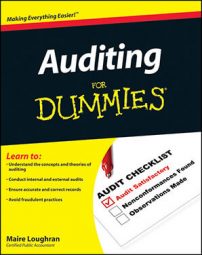At every step of an audit, you have to consider risks of misstatement and their associated controls. When you are auditing assets, be sure to focus is on identifying risks in the fixed-asset management process.
Generally, you look at two inherent fixed-asset risk factors: recording the correct cost basis, and working with complex (and, therefore, difficult to audit) accounting transactions.
Recording the correct cost basis: Your job as an auditor is to make sure the client has capitalized (added to the purchase price) all costs relating to the purchase or continuing use of fixed assets.
In addition, you must check the repairs and maintenance expense account to make sure any major repairs are added to the cost of the asset rather than expensed. What’s a major repair? Any repair that significantly increases the useful life of the asset. Getting a new set of tires for a company car is not a major repair, but rebuilding the transmission is.
Recognizing the complexity of book value calculations: Most fixed-asset calculations are fairly straightforward. When a client purchases fixed assets directly from vendors, you sample and test the source documents and consider the cost basis. Likewise, recalculating the audit client’s depreciation expense isn’t exactly rocket science.
However, lease accounting and dealing with fixed assets that aren’t purchased are inherently risky, because they’re complex accounting issues and can be difficult-to-audit transactions.
For example, your audit client may not understand the difference between the two types of leases (operating and capital) and may record all lease payments as expenses each month. Doing so for capital leases may cause the balance sheet and income statement to be not materially correct. To manage this risk, you need to sample and inspect leases to evaluate your audit client’s decision on how to treat each lease.
Transactions for the three types of nonpurchased assets — self-constructed assets, donated assets, and nonmonetary exchanges are also inherently risky. Why? You may have a difficult time verifying the costs applied to self-constructed assets, a donated asset’s fair market value, or an asset’s trade-in value. Your job is to apply professional judgment to see whether you agree with the client’s valuation and costs. You should discuss any disagreements with your audit team leader.
Just in case you’re pooh-poohing the inherent risk that can attach itself to these transactions, keep in mind that the fraud at WorldCom (one of the largest accounting frauds in history) involved fraudulently capitalizing expenses as property, plant, and equipment (PP&E).

